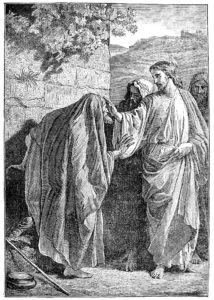In the Apolitical Jesus blog, I challenged you to read through the Gospels this political cycle while intentionally looking for the political dimensions of those texts. I am following up that challenge by blogging through Mark from this perspective.
The Scriptures are political texts.
The words “political” and “politics” are used to mean many things, so let me explain a little more how I understand this word in relation to the Scriptures.

One of the Merriam-Webster definitions (entry 5a) explains “politics” as “the total complex of relations between people living in society.” I will add into this the notion of power and authority. When I say that the Scriptures are political, I mean that among the chief concerns of the texts are the issues of what the people who have the power do with it. This is felt in “the total complex of relations between people living in society.” Because we, for the most part, are not intimately familiar with the power-dynamics that stand behind the complex of first-century societal relationships, we miss this dimension in the text. Early readers/hearers of these texts, of course, were very familiar with it.

Jesus, and us, are in the same position in this sense. Everything we do is political. Everything we do is caught up in the complex of social relationships, and is organized (in some measure) by those who hold the power in our various communities. One of my main hopes in this ongoing investigation is that you will see how much Mark, along with Jesus, actually questions the power structures that dictate social life.
There are a lot of ways to detail the political dynamics of the first-century Palestinian world. I have decided to explain them when they are relevant to the particular text, instead of collecting all the information in a standalone post.
I will highlight the political dimensions from two portions of Mark 1:
Mark 1:1-3
Really, Jared, the first verse is political? Yes, it is indeed.
In the opening verse of this text, Mark has decided to confront the political ideology of the Roman Empire head-on. He does this by writing in such a way that a political message from the Roman world is being subverted, an inscription which is today called the “Priene Calendar Inscription in Honor of Caesar Augustus” (9 BCE). This celebration of the birth of Caesar Augustus has a number of interesting elements, including that he is sent by “Providence” as the “savior” and “that he might end war and arrange all things.” It goes on to say that “the birthday of the god Augustus was the beginning of the good news for the world that came by reason of him.”
The Inscription is announcing the creation of a new calendar, beginning with Caesar Augustus’ birth, because with his birth a new order has been established. Providence has sent Augustus to be the Savior, to be the Emperor of Peace, which will be the beginning of the good news for the Roman Empire.
The message of Mark subverts this political ideology directly. “The beginning of the good news about Jesus the Anointed One, God’s Son” (1:1). Mark (many scholars think he actually writes the Gospel from Rome) says that the real good news begins with Jesus, not the emperor. The empire has their god-in-flesh in their emperor, while Mark has a different proposal about who is the God-in-the-flesh. As we continue into verses 2-3 of Mark, the quotation from Isaiah is another tit-for-tat with the Inscription. Providence sent you Augustus, while Yahweh is the one who is making sure that things are ready for this new order, for the Christ to come.
Mark’s engagement with the Inscription is offering his audience—right at the beginning of the Gospel!—two competing narratives. Do you want the Jesus story or the Roman story? Which one’s understanding of peace, rescue, and power will you orient your life around? Which lord will you prepare the way for? I encourage you to read all of Isaiah 40, it is a breathtaking introduction to the Gospel of Mark. (It is understood in biblical studies that when a biblical author includes a quotation, they are likely intending their audience to bring much more of the context into the present than solely the verse or two that are directly brought up.)
Mark 1:40-45
 A man with a skin disease approached Jesus, fell to his knees, and begged, “If you want, you can make me clean.” Incensed, Jesus reached out his hand, touched him, and said, “I do want to. Be clean.” Instantly, the skin disease left him, and he was clean. Sternly, Jesus sent him away, saying, “Don’t say anything to anyone. Instead, go and show yourself to the priest and offer the sacrifice for your cleansing that Moses commanded. This will be a testimony to them [/witness against them].” Instead, he went out and started talking freely and spreading the news so that Jesus wasn’t able to enter a town openly. He remained outside in deserted places, but people came to him from everywhere.
A man with a skin disease approached Jesus, fell to his knees, and begged, “If you want, you can make me clean.” Incensed, Jesus reached out his hand, touched him, and said, “I do want to. Be clean.” Instantly, the skin disease left him, and he was clean. Sternly, Jesus sent him away, saying, “Don’t say anything to anyone. Instead, go and show yourself to the priest and offer the sacrifice for your cleansing that Moses commanded. This will be a testimony to them [/witness against them].” Instead, he went out and started talking freely and spreading the news so that Jesus wasn’t able to enter a town openly. He remained outside in deserted places, but people came to him from everywhere.
While the chapter opens with a confrontation of imperial politics, it closes with a confrontation of religious politics. Torah details how those with a skin disease are to live outside of the community until the priest restores them by affirming their cleansing (Leviticus 13—14). They must live outside of the community so as to not make others physically, and therefore ritually, unclean. Uncleanness overpowers cleanness.
Jesus, though, reverses this. He touches the leper, and his cleanness overpowers the leper’s disease. Jesus, of course, does not contract the illness. Although Leviticus reserves the ability for a declaration of cleanliness to be made by a priest, Jesus does exactly that.
Now, hang tight with me for a minute. There are a couple of elements in this passage which seem a bit out of place. Why is Jesus “incensed,” and why does he speak “sternly” with the former-leper? One commentator on this Gospel opens this passage up a bit more to see what the original text is saying.
How are we to make sense of these strong emotions?
They only make sense if the man had already been to the priests, who for some reason had rejected his petition. Deciding to make an issue out of it, Jesus sternly gives the leper these orders… The cleansed leper’s task is not to publicize a miracle but to help confront an ideological system: … a protest against the entire purity apparatus which the priests control. He is to make the offering for the purpose of “witnessing against them” (eis marturion autois). This is a technical phrase in the Gospel for testimony before hostile audiences” (Ched Myers, Binding the Strong Man, p. 153).
Jesus sends the former-leper back as a testimony against their purity system. They used their religious authority to reject him. God’s Son has used his religious authority to restore him.
In the first chapter of Mark, I investigated just two instances where the Gospel is confronting the political order.
In the context of the empire, the Gospel offers an alternative narrative, an alternative vision of a savior, of good news, of someone to orient our life around. In the context of the religious dictates on purity, on who is or is not allowed in, Jesus sidesteps the priestly institution to bring physical and societal restitution to a leper. The religious leaders don’t get to be the gatekeepers of God’s welcome if Jesus is going to have a say. And so he (attempts to) sends the former-leper back as a witness against the institution.

As we look at the political dimensions of Mark’s Gospel, we must allow ourselves to be confronted:
I think we each need to explore how the good news of Jesus is an alternative narrative to the good news of the US. In which narrative do we find our beginning, and in which narrative do we find ourselves living?
Which narrative gets precedent over the other?
Christianity is the religion which holds the most political power in this country. How do portions of the church use its political power to give a no to a community on the margins, to be gatekeepers?
And how does the church use its power to say yes?
Where are we using our societal influence to reject instead of restore?




Any consensus among theologians on Mark 1:40 whether Jesus was “incensed” or “filled with compassion” that appears in some versions? Attempting to read the commentary in https://sites.google.com/site/inglisonmarcion/Home/mark/angry-or-compassionate
didn’t resolve the issue for me. It’s been said of economists, but looks like it also applies to theologians, if you line them up end-to-end they still point in different directions.
Thank you for “getting political !”
Ken, thanks for your reply. I use the CEB Bible, which takes the “incensed” reading, and the variant issue wasn’t on the forefront of my mind. In all of my Greek classes, the rule was always to stick with the harder reading, because manuscript transmission almost always makes things smoother and more compatible. The link you provided was interesting. The Syriac analysis is really interesting, although I think it could cut either way.
The other two passages where Jesus displays anger in Mark (3:5, 10:14), Jesus is angry about social constructs which, in Mark 3, promotes death rather than life and, in Mark 10, shuts out children from the Kingdom. The “incensed” reading makes sense along with the analysis in this blog that Jesus is incensed by the religious institution that shut out the leper. That being said, the “compassion” reading also makes sense with the many times Jesus shows compassion throughout Mark towards people who have also been disenfranchised in some way.
Overall, in my opinion, it does not change the interpretation of the text I have offered, that Jesus is sending the leper back (or attempting to, at least) as a witness against the broken institution. It just changes whether the initial encounter has Jesus responding out of compassion for the leper or anger for the institution that shut down the leper.
Which variant seemed more likely to you?
Thanks Jared, for giving us a fuller understanding of what is happening here.
Thanks Jared for helping us to see this more clearly.
Thought provoking, can’t wait to follow along with this series.